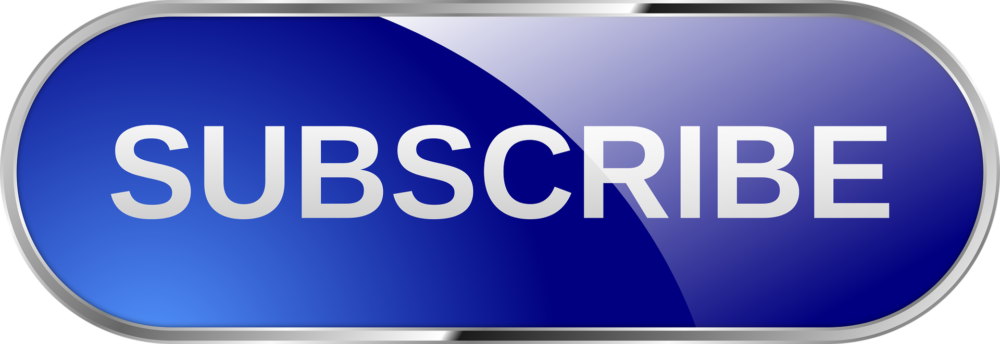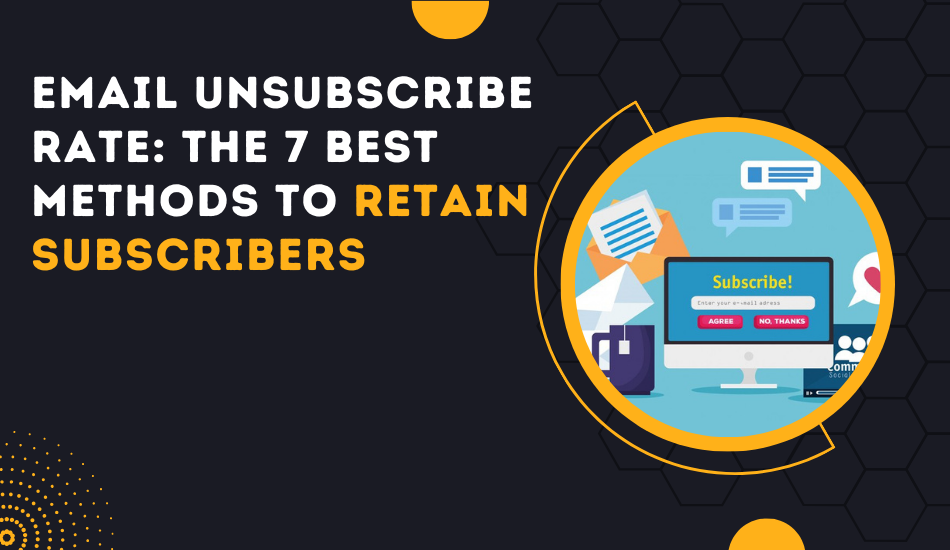Email Unsubscribe Rate: The 7 Best Methods To Retain Subscribers
If you are an aspiring digital marketer, who is involved in email marketing, reducing the email unsubscribe rate is crucial. That’s because the more users you retain on your email list, the better it is. And if you’re curious about methods to reduce your email unsubscribe rate, this post is for you.
So what’s email un-subscribe rate?
Remember, email recipients have the option of opting out of mailing lists. This is known as unsubscribing. And the percentage of email addressees that unsubscribe from an email marketing campaign is referred to as the email unsubscribe rate.
It is well established that it can cost 5 to 25 times more to find new customers than it does to keep the ones you already have.
According to Oberlo.com “81% of small businesses rely on email as their primary customer acquisition channel, and 80% for retention”. This demonstrates how important it is to keep your email unsubscribe rate minimal for your email marketing strategy.
As a result of research, it is understood that if your unsubscribe rate is less than 2%, you’re on the correct course and should endeavor to maintain it there, if not lower.
If you want to maximize your revenue and keep your subscribers interested, you must review your goals, content, and get to know your audience better.
So let’s get an insight into some proven ways of reducing your email unsubscribe rate.
1. Use Of Opt-in Forms For Email Subscription.
What is the distinction between a single and a double opt-in?
A single opt-in simply indicates that the subscriber does not need to verify their subscription.
Single opt-ins.
These are simpler for the user and the quickest way to create a list, but they are less considerate of your customers’ privacy. It’s a quick and painless process for users and helps grow your email marketing list quickly. It also allows you to quickly engage users with a promotion or discount.
The downside of a single opt-in is that your email address can quickly become clogged with poor data, harming your sender- reputation.

Double opt-ins.
In a double opt-in the subscriber must confirm by clicking a link emailed to them, after completing the initial form sign-up.
With double opt-in, users who receive your emails are less likely to complain about spam. It also ensures that your subscribers want to receive your emails by including an additional step in the signup process.
2. Audience Connect Vs Email Unsubscribe Rate
The goal of emails is always to educate and add value to the lives of your subscribers.
And guess how you do that.
The most effective way to persuade or connect with your audience is through education. You don’t have to constantly sell to them.
Rather, if your subject line appears to be a sales pitch, most people are unlikely to open it.
So what do you do?
The solution is to segment your subscribers so you can send them messages that are truly relevant to them. Divide your email subscribers into groups based on their interests and add them to multiple lists.
Make sure the messages go out on a regular schedule that isn’t too long or too short.
Also, go out of your way to avoid posting spammy-looking content.
3. Subject Lines: Effect On Unsubscribe Rate
What motivates you to open an email?
It’s the subject line. Right?
Your subject line is the first (and possibly last) impression you make on users. In many ways, your email subject line is more important than the body of your email.
After all, a fantastic newsletter is useless if it is never read.

According to Optionmonster.Com “47% of email recipients open an email based on the subject line alone? At the same time, 69% of email recipients report email as spam based solely on the subject line.”
So here are some useful tips for creating great subject lines:-
Create several subject lines.
Every email should have ten subject lines, and each email should have ten optional titles. Your job then is to select the best. And put that out as the final subject line.
Keep it to less than 50 characters.
It’s generally a good idea to keep subject lines to less than 50 characters.
Statistics show that subject lines with fewer than 50 characters have higher open and click-through rates than those with more than 50 characters. So if you exceed 50 characters, you risk being cut off by readers.
Alliteration.
An alliteration is a tongue twister like” Peter Piper picked a peck of pickled peppers”.Try it out for some creative email subject lines.
An abundance of alliteration attracts!
Avoid all-caps.

Covering your subject line IN CAPITAL LETTERS WILL NOT HELP.
Caps are extremely powerful, but they should not be taken lightly. As with loaded guns, use them sparingly and responsibly.
Besides, here’s another interesting fact.
Based on the latest research, experts will tell you that the most successful email subject lines are statistically composed of 3-5 words, 14-24 characters, and are written in title case.
However, the best advice for writing the perfect subject line is to write it like a human respecting another human.
4. Email Subscribers And Content Plan
Don’t just be a salesperson; add value and entertaining content as well.
The best practices to improve your content strategy is to:
1. Experiment with different types and formats of content.
2.Keep an Editorial Calendar.
3. Know what you want to say and don’t waste time saying it.
Here’s something more to do if you want to maintain the size and quality of your list.
Do include non-promotional messages in your strategy.
This may appear contradictory, but the more interesting and relevant content you send out, the more likely your recipients are to open your emails.
Don’t use clickbait or make obnoxious noises. Instead, write to your readers in a casual conversational manner and tell them exactly what they will gain from opening and reading your email.
5. Email Frequency: Effect On Unsubscribe Rate
There is no hard and fast rule regarding email frequency. If you have too few, you may be forgotten; if you have too many, you may end up in the spam box.
According to Campaignmonitor.Com “Our data suggests every two weeks is the “sweet spot” for getting the most people to see your emails without burning out your subscriber list. Though of course, you should always test to see what works best for you”.

So what’s a workable option that isn’t too stressful either for the sender or the recipient?
Well here’s what is workable.
Most small businesses send out an email to their mailing list once a month. And, if you do so, you could slowly increase it to twice a month.
After about 3 months, gradually increase it to weekly.
Consider sending emails two to three times per week if you have great content or regular promotions.
This is also an ideal chance for testing or directly asking your subscribers. In fact, an optimal sending frequency is also at the heart of reducing email unsubscribe rate.
You could even segment your subscribers based on their responses and schedule your emails to be sent at specified intervals.
Begin with a frequency you’ll be able to sustain and make sure to set those expectations in your welcome email. When you’re able to create more email content, poll your subscribers to see if they’d like to see more from you.
6. Following-Up Email Subscriptions
Don’t forget about your audience once they’ve become a registered user.
Matter of fact, the goal of email marketing is to build a long-term, active audience with whom you can communicate.
That’s why you need to remember, that a “fire and forget” approach won’t help the long-term customer base.
So here’s the thing.
Maintain contact with your audience by sending free educational content and requesting their input .
This will eventually assist you in improving your content and potential value as a business.
The more you interact and ask for feedback, the better you’ll get to know your audience and become a better information source, which will improve the expansion and viability of your business.
7. Email Unsubscribe Rate And Spam Filters
According to Statista.com, “Between October 2020 and September 2021, global daily spam volume reached its highest point in July 2021, with almost 283 billion spam emails from a total of 336.41 billion sent emails. As of August 2021, this number dropped to 65.50 billion.”
And here’s the interesting thing, email spam is one major factor leading to the high unsubscribe rate of emails.
The majority of email services have their own spam filters.

These filters detect unsolicited, unwanted, and virus-infested emails (referred to as spam) and prevent them from reaching email inboxes. And spam filters are used on both inbound and outbound emails.
Spam filters employ algorithms to sort through email messages. They look for emails that have characteristics that are similar to spam-like emails.
However, your email may bypass a spam filter at times.
But still, there’s a catch.
Even if your email passes through spam filters, that doesn’t mean the email is devoid of spam words. And very often, those words call your professionalism, and your product into question.
As a result, always check your email for spam trigger words, and assess whether your email looks professional. It shouldn’t violate any essential guidelines.
And lastly, consider whether there’s anything about your proposal that generates a lot of questions, but doesn’t provide solutions.
This quick check may help to reduce the unsubscribe rate drastically.
Related Posts
Don’t Start Email Marketing Until You Know These Best And Easy Tactics
Easy Steps To Craft Powerful Email Newsletters (Beginners)
Conclusion
If you are a budding digital marketer involved in email marketing, lowering your email unsubscribe rate is critical.
As a result, essential factors such as single or double opt-in forms call for close attention. Furthermore, you need to ensure that the frequency of the emails is not so high that it floods the recipient’s inbox or appears spammy.
And what’s most crucial is that you must craft your emails with care, and add generous amounts of educational and high-value content that isn’t spammy.
In any case, steer clear of clickbait subject lines in particular.
Above all, respect your customer as a human being whose needs you must meet, not vice versa.
Let me know in the comment box what you intend to do to reduce your mail unsubscribe rate.

